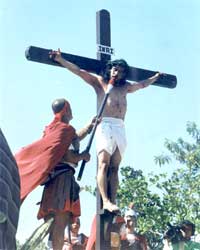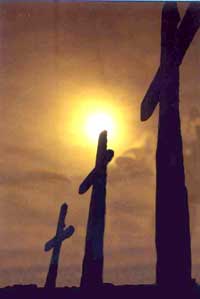Holy Week in the Philippines

Being the only Christian nation in the Far East, the belief of such religious observance was inherently Christian in origin brought to the Philippines by the Spanish Conquistadors when they first planted the Cross, symbol of Christianity, on the islands thus signaling the advent of the conversion of the natives to the faith of the Conquerors.
Holy Week culminates with all the solemn observance of Christian and pagan rituals. The practice is nationwide and has varying undertones of religious significance that is both moving and touching in its entirety. There are countless "Cenaculos" and "Pabasas" reciting and reenacting the passion and death of Jesus Christ in traditionally written verse form and dramatized version of the original sacrifice two thousand years ago.
The Holy Week in the Philippines has various appeals for everyone that combine native traditions and modern day touches with numerous innovations according to temperament and locale.
The week from Monday to Good Friday is an emotion packed series of religious ceremonies reminiscent of Christendom's most cherished traditions. Easter Sunday pall builds up into a glorious pealing of church bells for the pre-dawn "pasalubong", a reenactment of the Risen Christ's meeting with His Mother at the church patio under a specially prepared arch. An angel then descends from the platform and lifts the mourning veil of the grieving Mother amidst the pealing of bells. The procession of the two images then ends up inside the church and masses are said.
Lenten celebration in the Philippines is a conglomeration of quaint Christian and paganistic practices that are found nowhere else in the world. Some are breathtaking and exciting as they are charming and so distinctively Filipino that they are a source of wonderment for any tourist.
FLAGELLANTS
They scourge themselves in a somewhat paganistic manner considered medieval by many. This is done by stripping themselves naked from the waist up, walking barefooted under a midday sun and flagging themselves bloody with ropes and broken pieces of glass attached with strings to bamboo sticks. They do this as a means of atonement of their sins. It is a sort of retribution of their offenses and human weaknesses for past favor such as after going through some crisis or danger in their lives. This is commonly practiced in the provinces of Pampanga, Tarlac, Rizal and practically all over the Tagalog region.
PABASA
It's a family affair with the cooperation of relatives and neighbors. Others do these twenty four hours daily within the seven days of singing and reading of the Passion and Death taken from the verses of the Bible. Foods and drinks are being served to the singers.
BLACK NAZARENE
A century-old black statue in Quiapo, sculptured in Mexico during the Galleon Trade era, considered miraculous by devotees is brought out for procession every Good Friday. The statue is borne on the shoulders of male devotees in a slow, difficult procession around the narrow streets of the district, a score of men struggle to keep the image moving on. Thousands more try to muscle their way to touch the Nazarene as if carried by a powerful tide in an ocean of humanity.
SALUBONG
In Palawan it is reenacted in Iwahig Penal Colony participated by thousands of torch-bearing convicts in uniform line up in a pre-dawn ceremony.
MORIONES FESTIVALS
Marinduque Island is famous and known throughout the world. No one could recall its beginning but old folks claimed it started since time immemorial. Usually it is held in the plazas of Boac and Gasan. The towns present a spectacular pageant wherein people are dressed like Roman soldiers to commemorate the beheading of Longinos. The festivities have a Mardigras atmosphere.
BAGUIO CITY
Thousands of lowlanders, Manilans and foreign tourists flock to this summer capital to escape heat. Hotels and lodging houses are all booked a month before the Holy Week. Others trek to the mountain to view the city of pines and people enjoying the merry making not minding the religious people are in church for this Holy occasion.
SIETE PALABRAS
All radio stations throughout the nation are being sponsored by religious groups to air the reading of the "Siete Palabras" (Seven Last Words). There are series of speakers depicting the life of Jesus Christ and of course in different versions but the same meaning. Aglipayans, Episcopalians and Roman Catholics do this simultaneously.
VISITA IGLESIAS
In Manila it is a practice of Catholic believers to visit, if possible, 14 churches within Metro Manila representing the fourteen stations of the cross.
 BALA-AN BUKID
BALA-AN BUKID
Guimaras landmark, a huge white cross overlooking the City of Iloilo, a favorite pilgrimage venue of Visayan people.
HUGE 14th STATION
In Iguig, Tuguegarao oversized station of the cross at the hillside outside the centuries old church with a beautiful facade.
DAVAO CITY
Old folks still practice the traditional belief of not to create unnecessary sounds especially on Holy Thursday and Good Friday.
BICOL REGION
Bicolanos are too religious from Catanduanes, Sorsogon, Legaspi, Naga down to Camarines Norte and Sur, they have all the Holy Week rituals.
SAN PABLO CITY
Celebrities and movie stars from Manila and neighboring provinces join the most attended procession organized by Don Ado Escudero of Villa Escudero.
14 STATIONS OF THE CROSS
At the grotto of Lourdes in Novaliches, Quezon City the devotees, thousands of them, come during the Holy Week as a pilgrimage at the Calvary built with the fourteen stations of the Cross, life size, zigzagging at the hillside.
AMULETS HUNTERS
In Sipalay, Negros Occidental, it is a day for Herbolarios searching for anting-anting in unexplored caves on Good Friday.
FORTY FIVE STATUES
In Paete, Laguna procession of 45 statues beautifully decorated "carrozas" depicting the life of our Lord. Also in Siquijor, an island on the southern tip of Cebu, is well known for its Good Friday procession. Huge centuries-old statue fully decorated with fresh flowers.
CAPILYA
A town in Zamboanga still practices the old tradition of Lenten Season, one of which is the Capilya. Town people put up an improvised 14 altars around the poblacion representing the way of the cross. A group of singers sing ballad songs of Christ's passion.
CENACULOS
It is held in the Philippine Cultural Center sponsored by the Department of Tourism. Cast of characters include popular movie stars. In Taguig, Rizal they popularize the modern version of "Jesus Christ Superstar" reshown at the Fort Santiago Amphitheater for the benefit of Manilans. In Mexico, Pampanga and also Dinalupihan in Bataan there is one who actually had himself nailed to a cross for his "crucifixion" simulating Christ's passion as best as he painfully can.
PAGTALTAL SA JORDAN
In the Visayan region, we have now the famous "Ang PAGTALTAL SA JORDAN" in the island province of Guimaras. A reenactment of our Lord's sufferings on the way to the Calvary held every Good Friday at the Municipal grounds. For the last years, it was attended by dignitaries from America, Mexico, Costa Rica, Argentina, Netherlands, Spain, Germany, Canada, and thousands of tourists from European and Asian countries. Jordan town is widely known as the "GOLGOTHA" of the Philippines.
(*Secusana is the founder of Pagtaltal sa Jordan which is now in its 31st year.)
